With Bordeaux en primeur releases trickling through, the fine wine trade continues to speculate behind the scenes on which properties will provide the top picks from the 2020 vintage. To shine some light on the perennial châteaux to watch, we are looking back on the results of our latest in-depth trade survey, showing results of properties receiving the highest number of mentions in response to the following question:
Which Bordeaux properties do you think have the most potential in the near- to mid-term to see the highest increase in demand?
As answered by the 49 CEOs, MDs, and wine department heads from across the globe, wines from properties mentioned below are likely to see high demand again in this year’s en primeur campaign, thanks to their astute marketing and storytelling, usually coupled with a real step-up in quality.
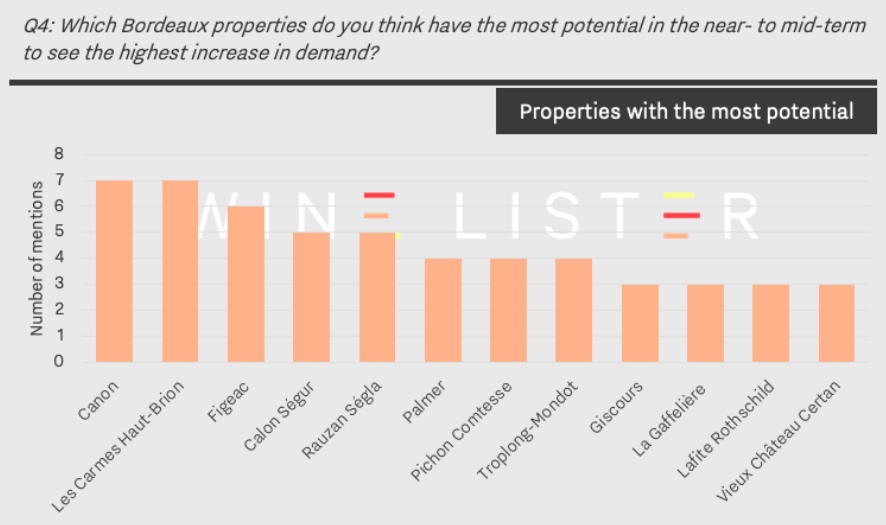 The survey results and graph above are extracted from Wine Lister’s latest Bordeaux Study
The survey results and graph above are extracted from Wine Lister’s latest Bordeaux Study
But how have they gained the confidence of the trade? Storytelling, backed up by real quality, thanks to serious investment:
Canon and sister property, Rauzan-Ségla have benefitted from investment by their owner, Chanel, as well as painstaking and perfectly judged branding efforts, accompanied by impeccable winemaking – with Managing Director, Nicolas Audebert front and centre of both undertakings. Calon-Ségur has been on a similar trajectory, reviving a sleeping beauty of a property with irresistible branding, excellent communication with the trade, and grand events. Pichon Comtesse has likewise benefitted from a perfect combination of exceptional wines, management and investment by its owners, Group Roederer.
If any one château were to serve as a masterclass in storytelling around a single event – in this case the 2018 vintage – it is Palmer, who turned the loss of the majority of its crop due to mildew into a silver lining, and turned the remaining production into something of a myth.
Figeac has made incredible wines the last three years with Managing Director, Frédéric Faye at the helm, returning it to the great quality of the last century – and better – and showing the true potential of its terroir. Significant investment by the Manoncourt family has also played a crucial role.
A rising star in recent years, Les Carmes Haut-Brion ties for joint-first alongside Canon. Small production levels, rising demand, and attractive en primeur pricing for the last few years has made Les Carmes Haut-Brion a top buy.
Lafite is the sole first growth to make an appearance, with three respondents mentioning it in their list of top properties likely to see the highest increase in demand, no doubt thanks to a raft of initiatives and modernisation thanks to a new generation of management in the form of Saskia de Rothschild and Jean-Guillaume Prats.
Also featuring are cult Pomerol pick Vieux Château Certan, Margaux staple Giscours, and from Saint-Emilion, up and coming La Gaffelière and newly fresh Troplong-Mondot.
Results are extracted from Part I of Wine Lister’s annual Bordeaux Study. You can download the study digest in English here: Wine Lister 2021 Bordeaux Study – Digest or French here: Wine Lister 2021 Bordeaux Résumé d’étude. The full report can be purchased on our Analysis page, while Pro subscribers can access their free copy here.
As another week of Bordeaux 2020 en primeur releases draws to a close, the campaign has begun to show signs of speeding up, with some compelling releases entering the market over the past three days.
Below we examine releases from Laroque (Wednesday 19th), Lafon-Rochet (Thursday 20th), and Branaire-Ducru and Batailley (Friday 21st).
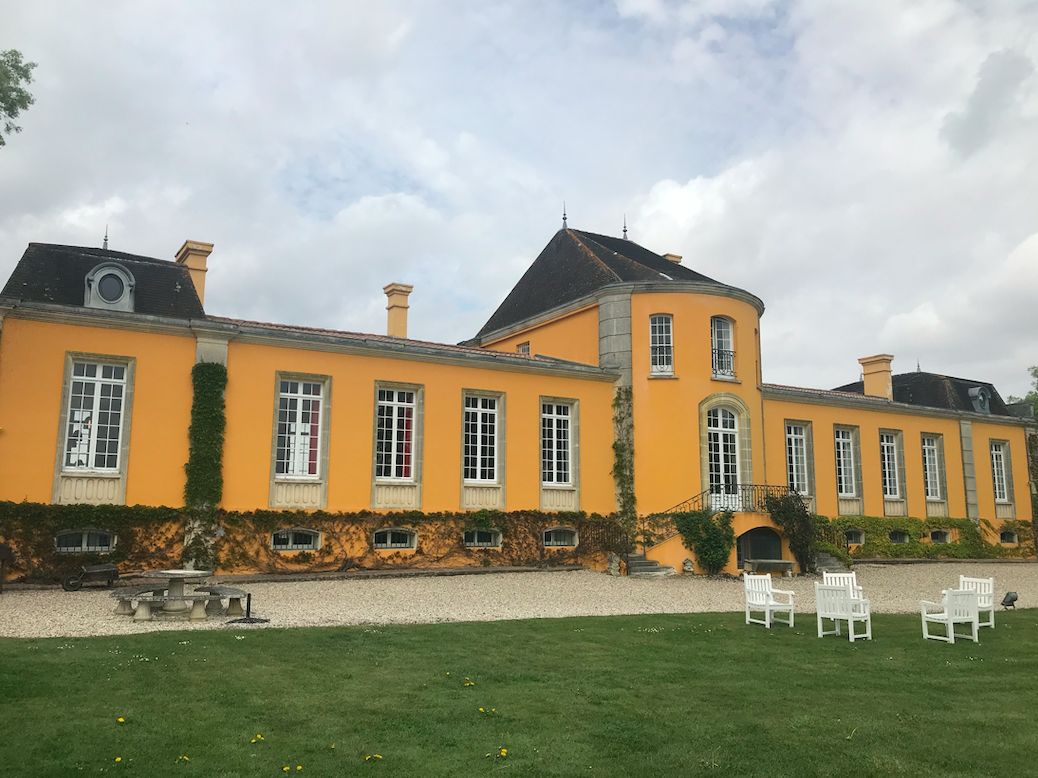 Lafon-Rochet’s latest release is a “very successful 2020”, according to Wine Lister partner critic, Jancis Robinson
Lafon-Rochet’s latest release is a “very successful 2020”, according to Wine Lister partner critic, Jancis Robinson
Released at £18.95 per bottle (in-bond), Laroque was described by Wine Lister CEO, Ella Lister as having an “ebullient, classy, very cassis nose”, developing into a “serious, structured wine on the palate”. The estate has seen recent improvements and investments to achieve a higher quality, starting with the hiring of David Suire in 2015, and the 2020 is no exception in the recent pattern of excellent value for money.
Lafon-Rochet’s latest vintage also illustrates the property’s upward quality trajectory. Having been awarded 17 points from Wine Lister partner critic, Jancis Robinson, (up from 16.5+ for the 2019) she describes it as a “very successful 2020” and congratulates owner, Basile Tesseron, for “producing something so appetising and groundbreaking”. Entering the market yesterday at c.£27.10 per bottle (in-bond), the vintage marks a year of development at Lafon-Rochet. As well as embarking on an agroforestry scheme in 2020 to enrich its environment, the latest release marks the inaugural collaboration of Jean-Claude Berrouet and Eric Boissenot, who worked together on its blending (recap our blog here). The price positioning of this top-quality vintage 10% below the 2019 market price has reportedly been very well-received.
Cru Classés Branaire-Ducru and Batailley were released this morning. Having made a name for itself as offering exceptionally good value within the Saint-Julien appellation, Branaire-Ducru’s latest release (at £31 per bottle in-bond) enters the market at an average 11% and 22% below than current availability of the 2019 and 2018 respectively.
Writing for JancisRobinson.com, James Lawther awards Batailley 2020 17 points, describing it as “Solid, subdued and distinctly Pauillac”. At c.£28 per bottle (in-bond), it enters the market under current average market prices of the last six vintages.
Keep track of en primeur releases on Wine Lister’s dedicated En Primeur Page here.
With the 2020 en primeur campaign now in full swing, the past two days have seen releases from the likes of Angélus, the Barton family, the Perse family, and more.
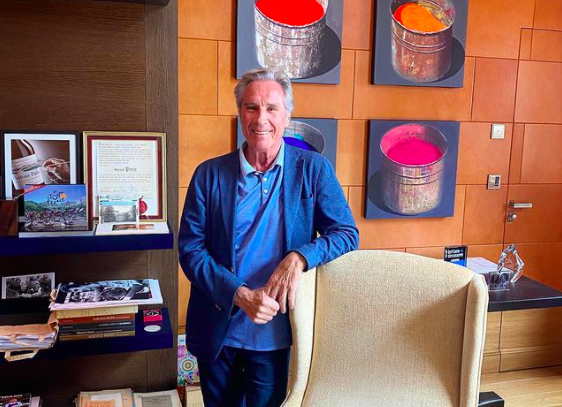 “Another big step in the right direction for this château in revealing its excellent terroir” – Wine Lister, CEO Ella Lister, who visited Pavie’s owner, Gérard Perse (pictured) last year
“Another big step in the right direction for this château in revealing its excellent terroir” – Wine Lister, CEO Ella Lister, who visited Pavie’s owner, Gérard Perse (pictured) last year
Released yesterday morning (Tuesday 18th May), the latest vintage of the Barton family wines – Léoville Barton, Langoa Barton, and Mauvesin Barton – has reportedly seen a positive uptake in the UK market already. Wine Lister partner critic, Jancis Robinson, gives high praise to the flagship release, Léoville Barton, awarding it 18 points, and noting that it shows “very fine winemaking indeed”, adding, “I have to admit I was tempted to swallow this, it was so majestic”. Wine Lister’s CEO, Ella Lister, also commends the latest vintage, describing a “sculptured structure which takes it into a different register”. The 2020 was released at £60.80 per bottle in-bond – over 10% higher than last year’s release, but potentially sporting the wine’s best quality to date.
Two more Saint-Émilion Grand Crus Classés “A” have joined fellow comrade and early-bird release Cheval Blanc, with Angélus entering the market at £254 per bottle (in-bond), and Pavie following closely behind at c.£241 per bottle (in-bond).
The latter gained resounding praise this year: James Lawther (for JancisRobinson.com) notes “absolute precision” which he says “more than highlights the change in style,” concluding, “one of the best yet”. Ella echoes this sentiment, asserting that “delightful floral freshness and a feather-light texture mark another big step in the right direction for this château in revealing its excellent terroir,” and calling the wine ”complex and refined”. The comments combined suggest that Pavie 2020 is the culmination of stylistic changes undertaken by the property over the last few years.
Perse family sibling, Pavie-Decesse 2020 was also released yesterday at £83 per bottle (in-bond). The latest vintage gains 17 points from James Lawther, who describes “Tension and minerality as well but plenty of charm this year”. With virtually no stocks of last year’s release remaining on the market, and the estate offering an element of rarity (at 3.5ha, it is a 10th of the size of Pavie), the latest release is likely to gain appeal beyond its volume released.
Also released so far this week are: Marquis d’Alesme, Labégorce, Coutet, Guiraud, Bellevue-Mondotte, and Monbousquet.
The Bordeaux en primeur 2020 campaign began in earnest last week, with Cheval Blanc the first of the major releases out of the gate. Its latest vintage was offered at a small, 3% increase on the 2019 release price, which itself came to market with a generous discount of c.30% on the previous year.
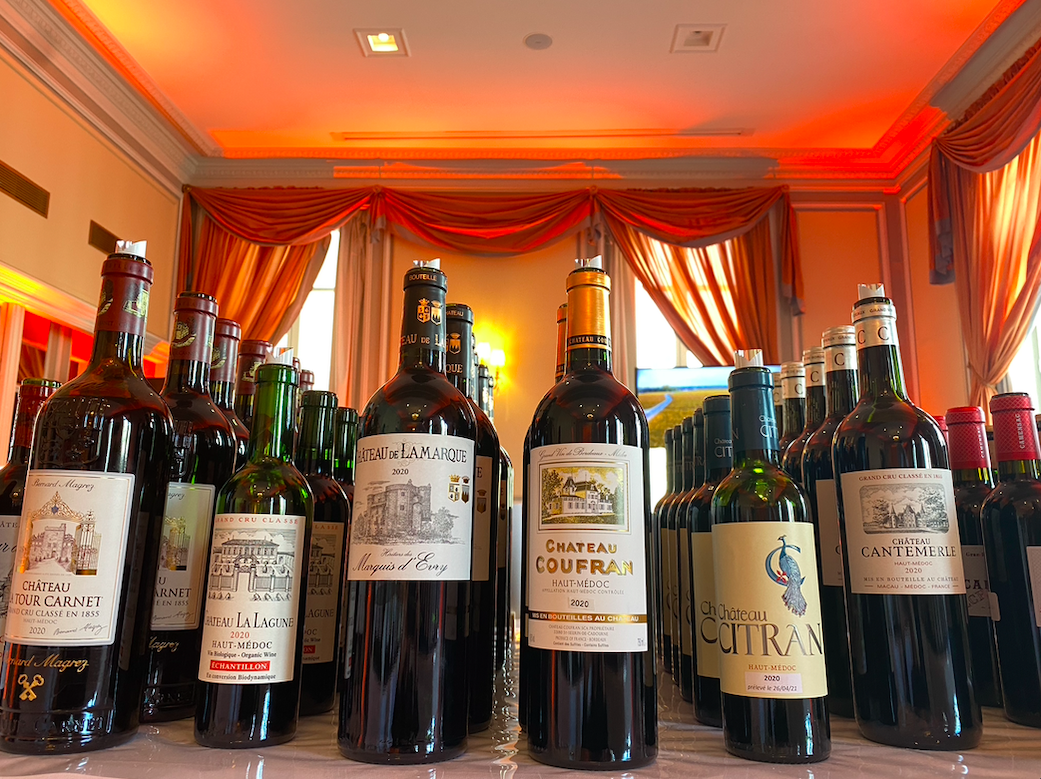 UGCB Tasting at The Intercontinental Hotel Bordeaux, attended by Wine Lister CEO, Ella Lister
UGCB Tasting at The Intercontinental Hotel Bordeaux, attended by Wine Lister CEO, Ella Lister
Absence makes the heart grow fonder
Much of the international trade has entered into a second consecutive year without the normal en primeur tasting week in situ. Instead, the bordelais have generally come up trumps with sending samples this year (only a very small handful of châteaux have declined to send any at all), and in many cases, one-on-one video calls have replaced the fleeting group tasting slots at the estates. Edouard Moueix, Managing Director of Etablissements Jean-Pierre Moueix observes how this has actually been a help, rather than a hindrance, in telling the story of the vintage to clients: “we can take time to explain things like we did some years ago”, he says. With a much wider range of tastings this year (albeit remotely for most) and a slightly less condensed campaign schedule, this should allow room for lesser-known wines that have excelled in the vintage to shine, where last year the sale of 2019s at lightning speed favoured well-known and trusted brands in the main.
While pricing is more often than not the hot topic for many participants in en primeur campaigns, sales of 2020 have the potential for focus on the great stories of each individual Bordeaux estate, given that the price equation this year is perhaps simpler than it has been in recent years.
Following a broadly successful “price reset” through the 2019 campaign, Bordeaux is holding all the cards that should ensure en primeur sales of 2020 work just as well (if not better), riding the wave of renewed interest in Bordeaux created last year. If 2019 prices set the precedent, then all that need happen now is to follow suit – matching last year’s release price, since the quality of 2020 for the majority of wines does the same. A healthier GBP-Euro exchange rate than existed last year should also help to keep price tags attractive, and choices for top-quality, excellent-value wines will hopefully be available in spades.
Follow Wine Lister’s en primeur analysis here on our blog, where we will be highlighting top picks from the 2020 vintage as they are released.
Recap Part I of our Bordeaux Study here for further analysis of en primeur pricing.
As Wine Lister enters its fifth year in business, we are excited to announce the addition of 650 new wines onto Wine Lister’s information hub. Thanks to scores from our trusted partner critics, prices through our official pricing partner, Wine Owners, and data measuring popularity, as determined by the number of searches on Wine-Searcher (Pro and Pro+ site only), website users can now discover Wine Lister scores, prices, and apply decision-making analysis tools to a broader range of fine wines. With the latest additions, our database now extends across 4,450 wines, and over 40,000 wine-vintages, providing further insight to inform wine investment choices and strategic solutions.
Below we examine the regional split of the additional wines, and take a closer look at some of the properties featured in the expansion.
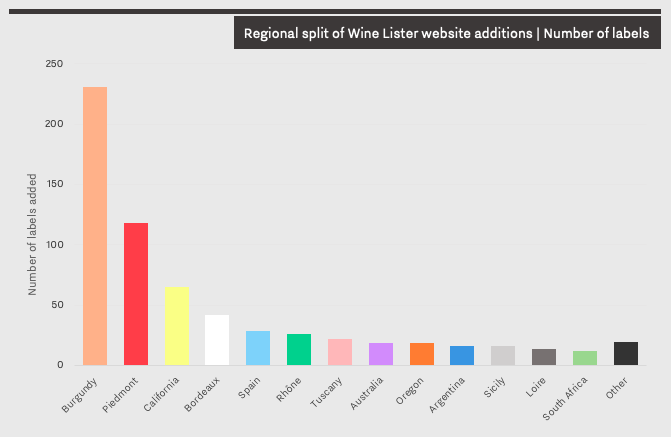
Burgundy represents 36% of the new selection, with more cuvées added from the likes of Pierre-Yves Colin-Morey, Cécile Tremblay, Benjamin Leroux, and more. A further 42 wines (6%) are added to the already-established set of Bordeaux properties featured on the Wine Lister site, including Cru Bourgeois Exceptionnels, Cambon La Pelouse, and Malescasse. Domaine des Roches Neuves represents seven out of the 10 new additions from the Rhône, alongside Bernard Baudry and Domaine du Closel.
Wine Lister’s Italian listings grow by 24% in the latest update, including 118 additions from Piedmont, 22 from Tuscany, and 16 from Sicily. The new Piedmontese picks include Arnaldo Rivera Barolo, Elvio Cogno, Figli Luigi Oddero, Giuseppe Mascarello e Figlio, and more. A region on the rise, Sicilian additions include new wines from organic Etna producers, Tenuta delle Terre Nere and Passopisciaro.
Wine Lister has also expanded its New World portfolio, which now features more additions from California (10% of the latest haul), Australia, and Oregon, among other regions. Featured amongst the new Californian picks are rising estates such as Littorai, Quintessa, Bevan, and Cardinale. Moving up the West Coast, Oregon additions include five new wines from Evening Land, four new bottles from Bergstrom, and three new picks from Antica Terra.
For more industry insights and advice on which wines and regions to buy, sign up for Wine Lister’s free newsletter here. Members of the trade can sign up to the Pro account to search and filter wines by Wine Lister Pro metrics.
Any of the producers recently added to the Wine Lister website can provide us with additional information on their wines, including production volumes, grape varieties, and label images. Email us at: team@wine-lister.com.
In Wine Lister’s latest Bordeaux Study, we examine a five-vintage retrospective analysis showing the greatest positive percentage change between wines at ex-négociant release price and current market prices.
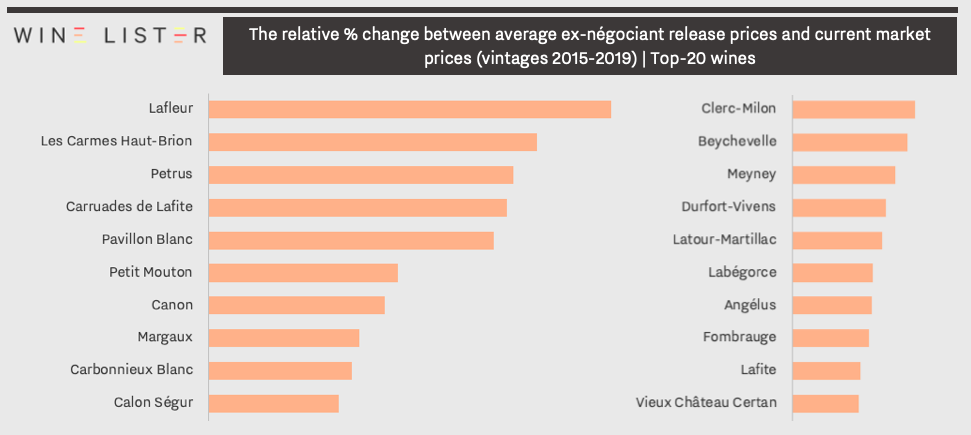 Top 20 by relative price change between average ex-négociant releases and current market
Top 20 by relative price change between average ex-négociant releases and current market
Which of the Bordeaux 2020 offerings show greatest price potential post-release?
One of the most significant periods of purchasing in a wine collector’s calendar is once again upon us. Bordeaux en primeur provides the opportunity to secure wines before they are bottled, with the primary benefits being both to gain access to crus that sell out quickly, and to pick them up at attractive prices, which will likely be higher once the wine becomes physically available.
Taking a closer look at the top-20 wines in the list, these bottles often see significant demand post- release, and are worth keeping an eye out for during the impending en primeur campaign.
Small-volume sensations
Lafleur, Les Carmes Haut-Brion, and Petrus typically see the greatest percentage changes in price, with all three producing notably small volumes within the context of Bordeaux – c.1,000, 1,800, and 2,500 cases per annum, respectively. With rarity on its side, demand for Lafleur has encouraged its original release price to grow by 115% on average in the secondary market.
Family of four
Four of the wines featured are produced under the same roof, or by the same team, as the Bordeaux First Growths, with demand surely heightened through association. Carruades de Lafite, Pavillon Blanc, Petit Mouton, and Clerc-Milon all offer potential price increase post-release, at a lower initial price than their Premier Cru siblings. Appearing fourth on the list, Carruades de Lafite has seen market price increase by c.56% post-release across the past five vintages, while the current cost of Petit Mouton is up c.54% on its ex-négociant price.
Rising through the ranks
Offering relative value and potential for future returns, several “rising stars” are featured in the ranking, and are worth watching over the upcoming releases. Canon, Calon Ségur, and trade darling for good value, Meyney have exhibited strong increases in quality over recent years, which has resulted in higher demand, and thus strong price performance after en primeur campaigns. The three promising picks have seen their average price increase by c.33%, c.24%, and c.19% respectively.
The full report can be purchased on our Analysis page, while Pro subscribers can access their free copy here. Wine Lister provides Pro+ subscribers with real-time en primeur release alerts during the campaign. Email us to enquire about signing up, or track releases prices on our dedicated en primeur page here.
As the fine wine industry starts preparing for another Bordeaux en primeur season at a distance, Wine Lister has published Part I of its annual in-depth Bordeaux Study. With insights from key fine wine trade players from across the globe, Part I evaluates Bordeaux’s recent performance, considers the major takeaways from the 2019 vintage campaign, and contemplates the lessons they might provide moving forwards.
Please see our key findings below:
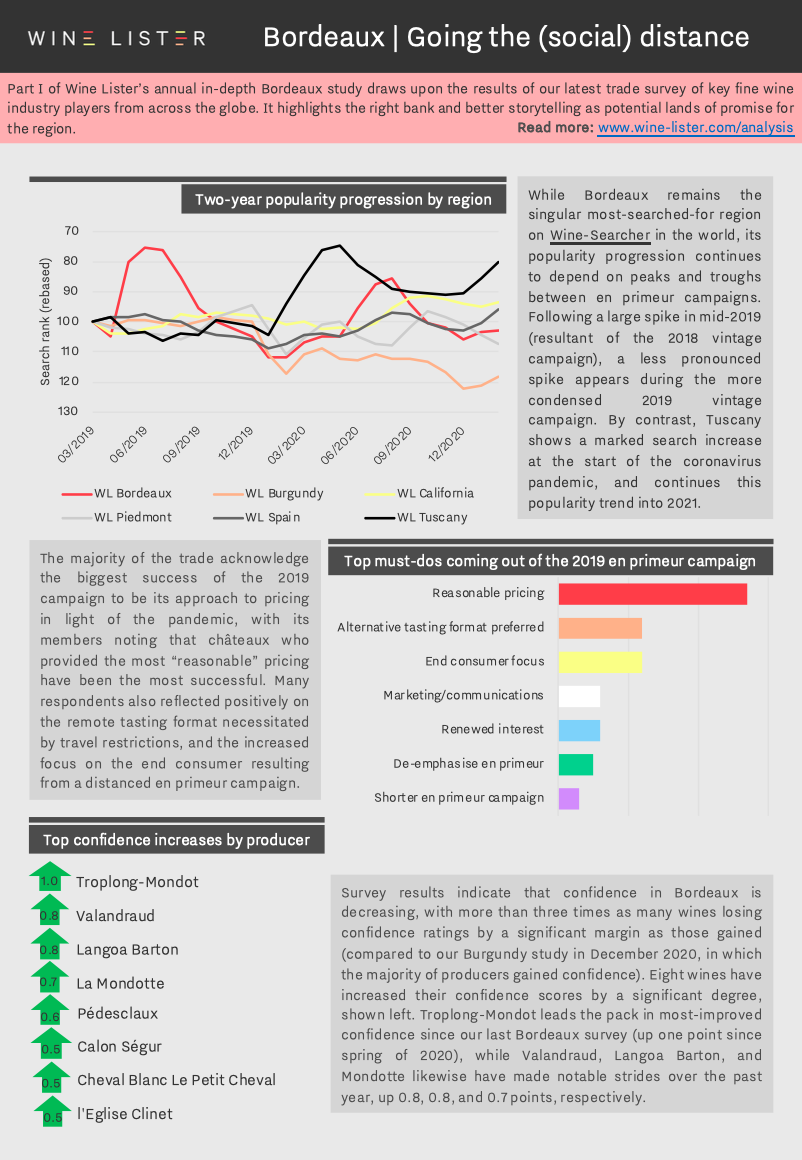
You can download the study digest in English here: Wine Lister 2021 Bordeaux Study – Digest or French here: Wine Lister 2021 Bordeaux Résumé d’étude. The full report can be purchased on our Analysis page, while Pro subscribers can access their free copy here.
With the bank holiday weekend approaching, Wine Lister has selected 10 mature Bordeaux MUST BUYs that promise to please with your Easter Sunday lunch. Boasting at least nine years of ageing, these top picks are available to purchase for under £100 (per bottle in-bond, when purchasing by the case in general).
Check out all of our Bordeaux MUST BUYs here, or read more below.
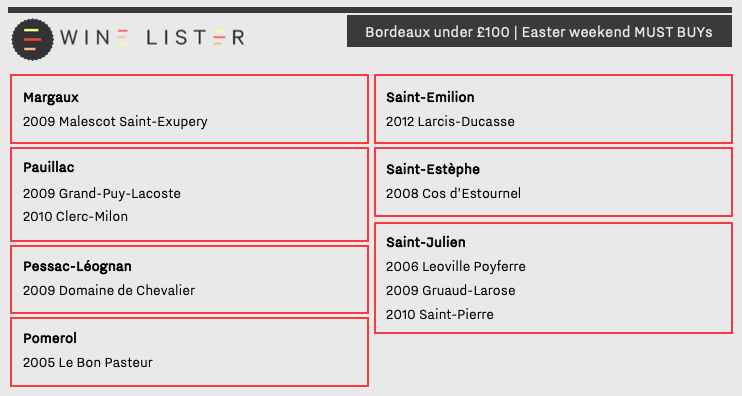
Regarded as a top-quality year for Bordeaux across appellations four of the 10 MUST BUY picks hail from 2009. Following a wet spring that provided plentiful water reserves, the summer of 2009 saw almost perfect growing conditions with minimal disease pressure, and many great wines from the vintage are beginning to either their optimum drinking window.
Described by Wine Lister partner critic, Jancis Robinson, as “very winning and opulent” with “massive volume and finish”, Margaux’s Malescot Saint-Exupery achieves a WL score of 93 in 2009. The property has exhibited an upward quality trajectory since the turn of the century, with the legendary Michel Rolland consulting on its production of a single, unfiltered and unfined wine. The 2009 vintage can be purchased from Fine+Rare for £71 per bottle (in-bond).
Grand-Puy-Lacoste’s 2009 vintage receives 18 points from Robinson, who notes; “a very sweet start. Herbal and interesting. Lots of fine tannin and savour. Very distinctive and ambitious”. Marking the estate’s highest WL score since its 1990 vintage (94), the 2009 is available to purchase from Bordeaux Index for £59 per bottle (in-bond).
Another classic left bank brand, Gruaud-Larose’s 2009 is described by Wine Lister partner critic, Neal Martin (Vinous), as offering refined aromas of “blackberry, cedar and leather”, and a “fine bead of acidity [with] great precision on the brown spice infused finish”. Hailed for the longevity of its wines, this can be enjoyed now, or aged for at least 10 more years. It is available from Bordeaux Index for £81 per bottle (in-bond).
Moving across to the right bank and back a few vintages, 2005 Le Bon Pasteur achieves the property’s highest ever WL score (94), and is described by Wine Lister partner critic, Bettane+Desseauve as offering notes of “dark fruits and fine chocolate”, and a “refined tannic structure, brilliant length and freshness”. With over 15 years of age, and only 2,500 bottles released, it has limited remaining market availability, but can be sought out for £100 per bottle (in-bond) from Cru World Wine.
Slightly south in Saint-Émilion, our chosen younger offering from Larcis-Ducasse – the 2012 – is available from Cult Wines for £41 per bottle (in-bond), making it the least expensive of the group. While rain in October forced many left bank estates to pick their late-ripening Cabernet Sauvignon earlier, the predominance of Merlot on the right bank saw its wines perform comparably better in 2012. Wine Lister partner critic, Jeannie Cho Lee, describes the 2012 Larcis-Ducasse as an “elegant, full bodied red with opulent tannins and wonderful energy”.
Last but not least, Saint-Estèphe star Cos d’Estournel makes the cut for its 2008 vintage. Robinson describes it as “very luscious and round” with a “strong blackcurrant element” and “surprisingly gentle tannins”. Achieving a WL score of 94, it is available to purchase by the bottle from Lay & Wheeler for £88 (in-bond).
Home to a range of grape varieties, styles, and DOCGs, Tuscany also offers excellent wines at a variety of price points. To help you on your hunt for a top Tuscan bottle within your budget, Wine Lister has compiled a selection of Tuscany MUST BUYs at five different price points.
Click here to view all Tuscan MUST BUYs, or read more below.
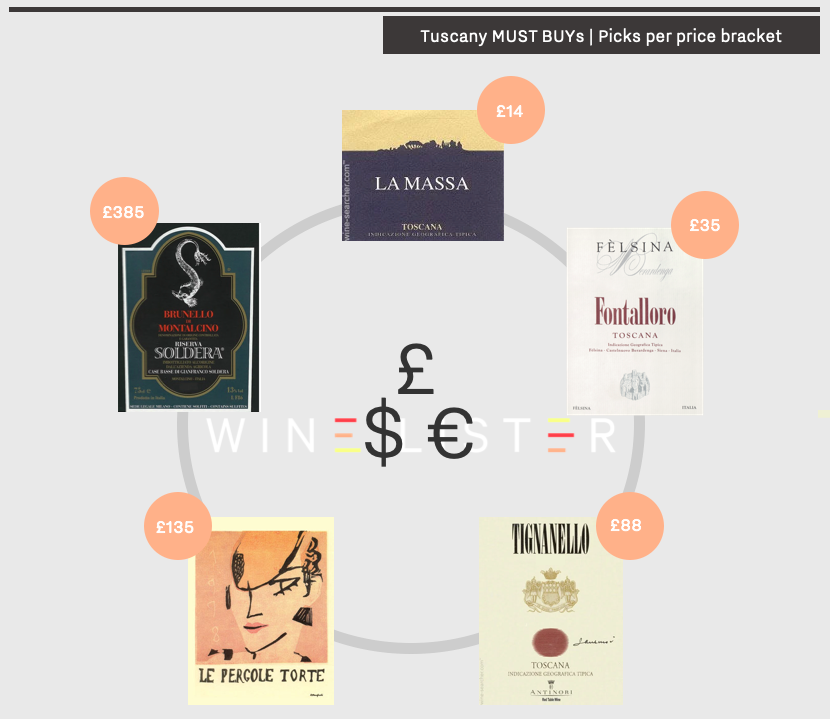 Prices are shown per bottle in-bond (when buying by the case).
Prices are shown per bottle in-bond (when buying by the case).
Under £20 – 2011 Fattoria La Massa La Massa
Founded in 1992 by prominent Chianti winemaker, Giampaolo Motta, Fattoria La Massa represents his aim of applying Bordeaux vinification techniques to a Tuscan terroir. With the counsel of famed Bordeaux vigneron, Stéphane Derenoncourt, Motta now grows Cabernet Sauvignon, Merlot, and Petit Verdot alongside native Sangiovese. La Massa comprises 60% Sangiovese, 30% Cabernet Sauvignon, and 10% Merlot in 2011, and is described by Wine Lister partner critic, Antonio Galloni as “jumping from the glass with dark red cherry, raspberry jam, plum, spices, violets, smoke and cloves”. With a WL score of 92, it is available to purchase from Bordeaux Index for £16 per bottle (in-bond).
Under £50 – 2015 Felsina Fontalloro
Felsina has seen a significant shift toward organic and biodynamic practices since its founder, Domenico Poggiali’s son-in-law, Giuseppe Mazzocolin, took over in the late 1970s. As well as investing heavily in a more natural viticulture, the estate has adopted a dedication to revealing the expression of its terroir. The 2015 Felsina Fontalloro was awarded 96 points from Antonio Galloni, who indeed notes that “sandy soils confer aromatic intensity to this super-expressive, arrestingly beautiful wine”. It can be purchased from Brunswick Fine Wines for £44 per bottle (in-bond).
Under £100 – 2016 Tenuta Tignanello Tignanello
Antinori’s Tenuta Tignanello property fared notably well in 2016, with its namesake wine, Tignanello achieving its joint-highest WL score alongside its 2015 vintage (98). Antonio Galloni describes the 2016 Tignanello as “flat out stunning”, and muses, “I don’t think there is another wine anywhere in the world made entirely from estate fruit that can match Tignanello for quality, consistency and value”. A blend of 80% Sangiovese, 15% Cabernet Sauvignon, and 5% Cabernet Franc, it can be acquired from Fine+Rare Wines for £92 per bottle (in-bond).
Under £200 – 2015 Montevertine Le Pergole Torte
Considered a difficult place for any agricultural production, Radda was an unusual location for Montevertine’s founder, Sergio Manetti to establish his property in 1967. In one of the highest and rockiest sites in Chianti Classico, its steep hills are now home to top-quality Sangiovese vines from which its three wines – Pian del Ciampolo, Montevertine, and Le Pergole – are produced. Antonio Galloni awards 97 points to the 2015 Montevertine Le Pergole Torte, calling it “deep, powerful and resonant […] exotically ripe and flamboyant, not to mention utterly captivating”. It can be bought from IG Wines for £129 per bottle (in-bond).
Over £300 – 2008 Soldera Case Basse Sangiovese
Achieving 18 points from Wine Lister’s partner critic, Jancis Robinson, Soldera’s 2008 Case Basse Sangiovese is described as “so different from most Brunello” with a “reserved nose of autumnal leaves”, and a “real tang on the end”. Having separated from the Brunello di Montalcino DOCG in 2006, all vintages from 2007 onwards are labelled as Toscana IGT. The 2008 marks a shift away from the estate’s usual vinicultural methods, having been aged for a period in stainless steel before bottling. Antonio Galloni notes that it is indeed “quite different from virtually every other wine made at Case Basse”. The 2008 Case Basse Sangiovese can be bought from Fine+Rare Wines for £387 per bottle (in-bond).
Over two years ago, Wine Lister published a blog on Tuscany’s 2018 vintage (recap here), which has since become the second most-read article on our site. With several 2018s entering the market over the past six months, and more scheduled for release this year, news of the vintage remains relevant.
To complete the picture first painted in our report on the 2018 harvest, we examine how some of the wines discussed have performed so far, and whether predictions on the vintage have come to fruition.
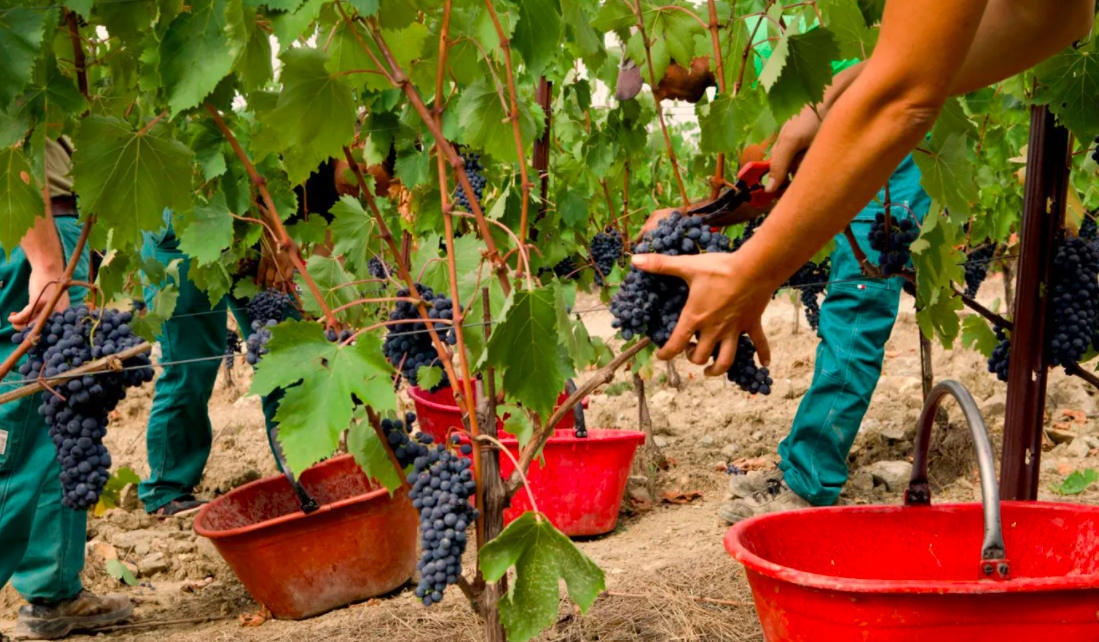 A prized picking – the 2018 harvest at Castello di Fonterutoli
A prized picking – the 2018 harvest at Castello di Fonterutoli
Predicting in 2018 that “the vintage might fall between the opulent 2015s and the structured 2016s in terms of quality and style”, Castello di Fonterutoli’s Giovanni Mazzei underestimated the year. The estate’s 50% Sangiovese and 50% Merlot blend, Siepi, achieves its highest score from Wine Lister’s partner critic, Antonio Galloni in 2018 (97) – five and two points above the 2015 and 2016, respectively. Antonio notes it is “rich, pliant and creamy”, offering “all of the seductiveness of Merlot with the bright acids and grip of Sangiovese”. The 2018 Siepi can be bought from Petersham Cellars for £70 per bottle (in-bond).
Estate Director at Ornellaia and Masseto, Axel Heinz told Wine Lister in 2018 that his “fermenting wines are silky and fragrant”, and that he predicts “a more delicate vintage”. Indeed, Antonio Galloni recently wrote on the 2018 Ornellaia that “readers should expect a silky, aromatic Ornellaia in line with vintages such as 2004 that are more about finesse than raw power”. Having been previewed by members of the fine wine trade and press in a virtual seminar last week (recap our recent blog here), it was awarded a score of 97 by Antonio. The 2018 Ornellaia will be released onto the market at the beginning of April.
Due for release through the Place de Bordeaux in September, Masseto’s 2018 vintage was the first to be made in its own winery, having previously been vinified at Ornellaia. Awarding it 98 points, Antonio notes that it is “silky, mid-weight and supremely gracious”, with notes of “inky red/purplish fruit, cedar, lavender, espresso, sage and mint”. Wine Lister sampled the second release of Masseto’s second wine, 2018 Massetino, in September 2020, and was certainly impressed by its complexity, with expressive notes of dark fruit, cocoa, and spice. While it has limited remaining market availability, it can be purchased from Cru World Wine for £307 per bottle (in-bond).
Describing 2018 as “a good year”, Fattoria Le Pupille’s owner, Elisabetta Geppetti, told Wine Lister that the Bordeaux varietals of her flagship wine, Saffredi, fared particularly well. Antonio Galloni gives it 96+ points, and writes that “the 2018 Saffredi is a regal, elegant, supremely polished wine”, which “may very well be the most refined Saffredi I have ever tasted”. Recalling notes of “sweet red cherry, plum, mocha, licorice and cinnamon”, he concludes; “don’t miss it”. It can be bought from Berry Bros & Rudd for £60 per bottle (in-bond).
Keep track of new Tuscany 2018 scores from Wine Lister partner critics here, and watch this space for future analysis on the vintage.
 The survey results and graph above are extracted from Wine Lister’s latest Bordeaux Study
The survey results and graph above are extracted from Wine Lister’s latest Bordeaux Study







